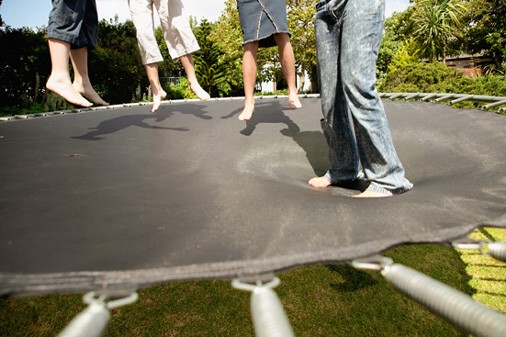Atomic Trampoline
You could measure the strength of gravity by launching a ball upwards with a precisely known velocity and then timing how long it takes to come down again. In the 17 April Physical Review Letters, researchers describe that experiment on a microscopic scale. They tossed a cloud of atoms and allowed it to “bounce” back up after each fall, as many as 100 times in a row. The experiment does not yet yield a gravity measurement of great accuracy, but the researchers believe the technique could lead to a workable “gravimeter” small enough to use in navigation systems that depend on acceleration measurements.
Researchers can measure gravity with high precision using an atomic “fountain,” in which they record the rise and fall time of a cloud of cold atoms tossed up by a laser pulse. But accurate measurements require vertical distances of tens of centimeters or more.
So Charles Sackett and his colleagues at the University of Virginia in Charlottesville tried a technique that replaces the long rise and fall distance with the shorter height needed for many small bounces. They began with about 10,000 atoms of rubidium-87 magnetically trapped in a tiny Bose-Einstein condensate, in which all the atoms belong to a single quantum state. After allowing the atoms to fall, they sent a pulse of laser light upward through the chamber. Interacting with its own reflection coming down from a mirror, the pulse created standing waves, in which the crests and troughs of the light’s electromagnetic field form a stationary pattern.
The trick in this experiment was to time the laser pulse precisely, so that the downward momentum of the accelerating atoms was exactly equal to that of the photons. If the momenta match, it turns out that atoms absorb an upward moving photon and quickly emit a downward moving one, precisely reversing their motion. After the laser pulse, the atoms rose and fell freely through a distance of a few microns, allowing the researchers to time another laser pulse to bounce them back up again. The idea was independently proposed a few years ago by other researchers but never tested [1].
By adjusting the timing to keep the atoms bouncing for about 125 milliseconds, the researchers could accurately measure the duration of one up-and-down cycle and then calculate g, the acceleration due to gravity. Their value was off by about 5%, which they attributed mainly to the influence of the earth’s magnetic field on the atoms’ motion. Correcting for this, Sackett and his colleagues revised their estimate of g to within 0.04% of the correct value.
To improve their measurement of g, the team applied a somewhat different sequence of laser pulses and put the cloud into a two-part quantum state, so that–in the weird reality of quantum systems–the atoms followed two different trajectories simultaneously. In one trajectory, the atoms bounced as before, while in another trajectory, physically below the first, they alternately bounced up and down, as if hitting both a floor and a ceiling. In this second trajectory, the atoms moved faster overall and were represented by a quantum wave with a shorter average wavelength. Recombining the two states later revealed the difference in their waves, caused partly by their different speeds.
In fact, says the team, this second experiment yielded a slightly worse estimate of g than the first, largely because of differences in the way the upper and lower trajectories responded to the laser pulses. The team hopes to rectify that by shooting two laser beams at each other to create a more complex standing wave pattern. That modification would also allow a greater separation between the two paths, increasing sensitivity.
“This is a very clever method,” says Holger Müller of the University of California at Berkeley. Particularly if the second technique is improved, he says, it could provide a way of measuring gravity with a small device.
–David Lindley
David Lindley is a freelance science writer in Alexandria, Virginia.
References
- F. Impens, P. Bouyer, and C. J. Bordé, “Matter-wave Cavity Gravimeter,” Appl. Phys. B 84, 603 (2006).
More Information
Fountain Clock Keeps Good Time (Focus story from 1999)





